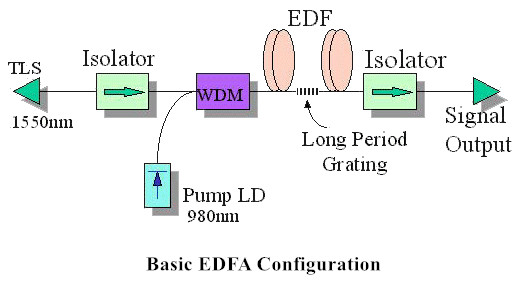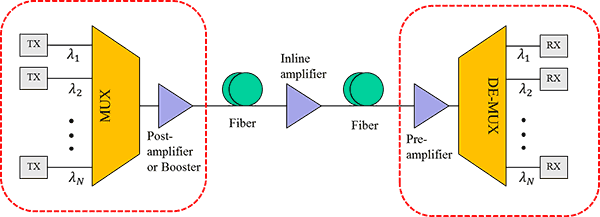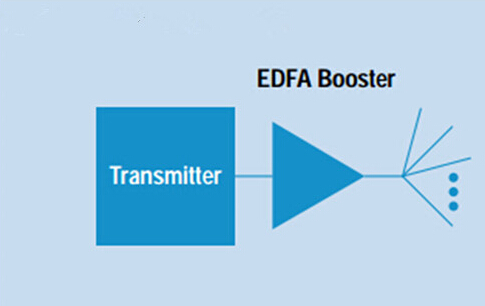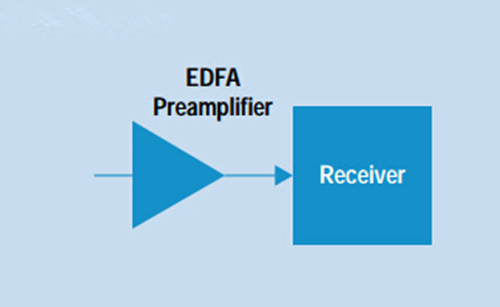Erbium doped fiber amplifier (EDFA) is the latest state-of-the-art solution for amplifying optical signals in optical transmission systems. It has become a key enabling technology and the dominant amplification device deployed in optical networks. Together with DWDM technology, EDFA has made it possible to transmit data over long distance. Broadly speaking, optical amplifiers may be used within an optical network as boosters, in-line amplifiers and pre-amplifiers. This article guides you to optimize your DWDM network reach by setting EDFA amplifiers in proper position.
EDFA works to directly amplify any input optical signal, eliminating the need to convert the signal into the electrical domain, thus offering the potential to reduce bandwidth transport costs. Since fiber attenuation limits the reach of a non-amplified fiber span to approximately 200 km, wide area purely optical networks cannot exist without an optical amplifier. Currently, EDFA has gained in more popularity because of features such as polarization independent gain, low noise, low cost and very low coupling losses.

The basic form of EDFA consists of a length of EDF, a pump laser, and a WDM system for combining the signal and pump wavelength so that they can propagate simultaneously through the EDF. The most common configuration of EDFA is the forward pumping configuration using 980nm pump energy. Which offers the best overall design with respect to performance and cost trade-offs.
Within a DWDM system, EDFA can be placed in three different places for power compensation: used as booster optical amplifiers on the transmitter side to provide high input power to the fiber span, as in-line amplifiers to compensate for fiber loss in the transmission, and as preamplifiers at the receiver end to boost signals to the necessary receiver levels.

A booster optical amplifier operates at the transmission side of the link, working to amplify aggregated optical input power for reach extension. Booster EDFA is designed to enhance the transmitted power level or to compensate for the losses of optical elements between the laser and optical fibers. It is usually adopted in a DWDM network where the multiplexer attenuates the signal channels. Booster optical amplifier features high input power, high output power, and medium optical gain.

An in-line amplifier is generally set at intermediate points along the transmission link in a DWDM link to overcome fiber transmission and other distribution losses. Optical line amplifier is designed for optical amplification between two network nodes on the main optical link. In-line amplifiers are placed every 80-100 km to ensure that the optical signal level remains above the noise floor. It features medium to low input power, high output power, high optical gain, and a low noise figure.

A pre-amplifier operates at the receiving end of a DWDM link. Pre-amplifiers are used for optical amplification to compensate for losses in a demultiplexer located near the optical receiver. Placed before the receiver end of the DWDM link, pre-amplifier works to enhance the signal level before the photo detection takes place in an ultra-long haul system, hence improving the receive sensitivity. It features medium to low input power, medium output power, and medium gain.

By placing booster optical amplifier, optical line amplifier and pre-amplifier in different position of a DWDM link, the possible network reach extension can be achieved.
Distances of optical transmission systems can be extended by using EDFA. Three different EDFA types can be used depending on the required distance and existing locations. Simply by putting a booster optical amplifier at the beginning of a DWDM link, up to 170 km can be accomplished in a point-to-point connection.

As the booster amplifier set at the beginning extends the link reach to 170 km, with the additional use of a pre-amplifier at the end of a transmission, the achievable distance of the entire system can be increased up to 250 km.

Installing an EDFA at one repeater site, a distance of up to 400 km can be realized. And this can be further extended if more repeater sites are used to place optical line amplifier. All three types of amplifiers are already designed to support 100 Gbps bandwidth for realizing up to 1000 km in a point-to-point connection. For this purpose multiple repeater sites and a Forward-Error-Correction (FEC) integrated in the used optics are required.

Appropriate deployment of EDFA as booster, in-line amplifier and pre-amplifier in a DWDM link contributes to optimize network performance for extending the reach. Which also increases data capacity required for current and future optical communication system. Hope the discussion in this article is informative enough to get a better understanding of EDFA optical amplifier.




